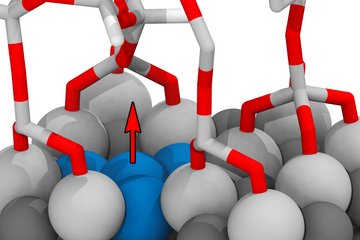All genres
281.
Talk
The Binary Fe–Al System. 5th Discussion Meeting on the Development of Innovative Iron Aluminium Alloys (FEAL 2009), Prague, Czech Republic (2009)
282.
Talk
Phase-transformation kinetics in the TiCr2 Laves phase. MRS Fall Meeting 2008, Boston, MA, USA (2008)
283.
Talk
Unidirectional solidification and single crystal growth of Al-rich Ti–Al alloys. MRS Fall Meeting 2008, Boston, MA, USA (2008)
284.
Talk
Ab inito study on elastic properties of Fe3Al-based alloys. MRS Fall Meeting 2008, Boston, MA, USA (2008)
285.
Talk
Precipitation reactions in Ti40Al60 and Ti38Al62 alloys and symmetry relations of the phases involved. MRS Fall Meeting 2008, Boston, MA, USA (2008)
286.
Talk
Structure and disorder of the Laves phases in the Co–Nb system. MRS Fall Meeting 2008, Boston, MA, USA (2008)
287.
Talk
An in-situ electron microscopy study of microstructural evolution in a Co–Co2Nb binary alloy. MRS Fall Meeting 2008, Boston, MA, USA (2008)
288.
Talk
Phase Equilibria in the Ternary Nb–Cr–Al System and Site Occupation in the Hexagonal C14 Laves Phase Nb(Cr,Al)2. MRS Fall Conference 2008, Boston, MA, USA (2008)
289.
Talk
Structure and unusual mechanical behaviour of the intermetallic compound Nb2Co7. MRS Fall Meeting 2008, Boston, MA, USA (2008)
290.
Talk
Composition Dependence of the Mechanical Properties of Laves Phases in the Binary Nb–Fe and the Ternary Nb–Fe–Al System. MRS Fall Conference 2008, Boston, MA, USA (2008)
291.
Talk
Eutectic NiAl-Re alloys processed under microgravity. TEMPUS Parabolic Flight April 2008 Meeting, Bonn, Germany (2008)
292.
Talk
The nature of Laves phases: Observation of defect softening. Materials Science and Engineering MSE 2008, Nuremberg, Germany (2008)
293.
Talk
Investigation of the crystallographic structure of the ε phase in the Fe–Al system by high-temperature neutron diffraction. 20th Annual Rio Grande Symposium on Advanced Materials 2008, Albuquerque, NM, USA (2008)
294.
Talk
Nb-based Laves phases - Stability, structure and disorder. 16th Int. Conf. Solid Compounds of Transition Elements SCTE 2008, Dresden, Germany (2008)
295.
Talk
Preliminary in-situ TEM observations of phase transformations in a Co–15 at.% Nb alloy. Workshop "The Nature of Laves Phases XI", MPIE Düsseldorf, Germany (2008)
296.
Talk
Composition dependence of site occupancy and c/a ratio in hexagonal C14 Laves phase of the Nb–Cr–Al system. TOFA Thermodynamics of Alloys 2008, Krakow, Poland (2008)
297.
Talk
Rietveld refinement of site occupation in ternary Nb(Cr,Al)2 Laves phase. Workshop "The Nature of Laves Phases XI", MPIE, Düsseldorf, Germany (2008)
298.
Talk
Phase equilibria in the Cr–Ti system studied by diffusion couples and equilibrated two-phase alloys. Workshop "The Nature of Laves Phases XI", MPI für Eisenforschung, Düsseldorf, Germany (2008)
299.
Talk
Phase equilibria of Laves phases in ternary Nb–X–Al systems with X = Cr, Fe, Co. Discussion Meeting on Thermodynamics of Alloys - TOFA 2008, Krakow, Poland (2008)
300.
Talk
The mechanical properties of Nb–TM Laves phases - Sample preparation and the composition dependence of the microhardness in Nb–Fe Laves phases. Workshop "The Nature of Laves Phases XI", MPI für Eisenforschung, Düsseldorf, Germany (2008)











